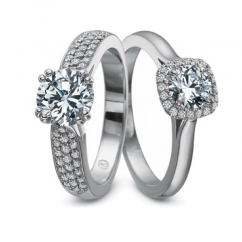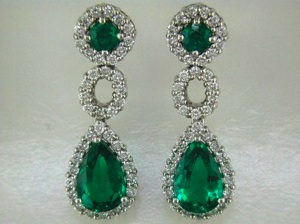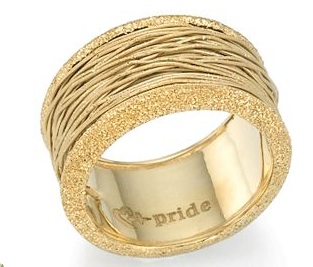Articles and News
“MARRIAGE OPTIONAL” ONE OF 10 KEY TRENDS TO WATCH FOR 2012, SAYS JWT AD AGENCY | December 07, 2011 (0 comments)

New York, NY—J. Walter Thompson has issued its seventh annual report of top macro-trends to watch for the coming year. For 2012, JWT says continued economic uncertainty, new technology, and the idea of shared responsibility are driving many of the top trends it has identified. Among the trends it identifies is one it calls "marriage optional," meaning more women and couples are opting out of the wedding.
The report is the result of quantitative, qualitative, and desk research conducted by JWT Intelligence, both throughout the year and specifically for the report.
The executive summary explains, “Trends don’t happen in isolation. They tend to intersect and work in tandem with each other. Many are extensions or outgrowths of trends we formerly spotted; after all, trends with real significance can’t be assigned to just one calendar year. The trends explored here, which we believe have significant weight and momentum, indicate shifts that are likely to be with us for a while.”
The top trends are: 1) Navigating the New Normal, 2) Live a Little, 3) Generation Go, 4) The Rise of Shared Value, 5) Food as The New Eco-Issue, 6) Marriage Optional, 7) Reengineering Randomness, 8) Screened Interactions, 9) Celebrating Aging, and 10) Objectifying Objects.
Here is JWT’s executive summary (in Roman type), each coupled with The Centurion Newsletter’s editorial take on its relevance to luxury jewelers (in italic type):
1. Navigating the New Normal: As the new normal becomes a prolonged normal in the develop world, more brands in more categories will open up entry points for extremely cost-sensitive consumers. Marketers will find new opportunities in creating stripped-down offerings, smaller sizes, and otherwise more accessible products and services.
The Centurion’s take on this trend: Luxury jewelers already participate in this trend through “affordable luxury” lines like Pandora or ToyWatch, which allow customers to participate in the full store experience for a small bit of cash. Consumers will expect their jewelers to continue offering selections in these categories.
2. Live a Little: Faced with constant reminders about what to do (exercise more, eat better) and what not to do (smoke, overspend), and fatigued from several years of austerity, consumers will look for ways to live a little without giving up a lot. People have been exercising more self-control, and increasingly they’re looking to let loose once in a while, indulging in sinful things, splurging on treats, and escaping from today’s many worries.
The Centurion’s take: Estee Lauder chairman Leonard Lauder’s famous “lipstick index,” shows small indulgences are important: lipstick sales increase in tough times. For jewelers, affordable luxury lines are one way to address this desire, but to drive larger sales, remember that consumers tend to feel better about splurging if they can justify the purchase as something that also does good for someone else. Look into increasing cause-related marketing, charity-benefiting products, and charity-driven promotions.

Estee Lauder chairman Leonard Lauder said lipstick sales rise in hard times. It's a small indulgence that doesn't cost much but makes women feel good.
3. Generation Go: JWT says that while 20-somethings in the developed world feel they’ve been dealt an unfair deck, many are finding opportunity in economic adversity. Out of continued joblessness or discontent with the status quo will spring an unprecedented entrepreneurial mindset, enabled by technology that obliterates traditional barriers to entry. A so-called Lost Generation will transform itself into a uniquely resourceful cohort.
The Centurion’s take: While this generation did hit adulthood in a particularly tough economic climate (the “unfair deck” it feels it’s been dealt), it is still largely a group whose values were formed by an indulged childhood, and it is a cohort both familiar with, and at least to a degree used to owning, luxury brands. But it’s also a group who are fierce price-shoppers and who expect brands they buy to have valid justification for the prices they charge. They also expect merchants to be as technologically proficient as they are.
4. The Rise of Shared Value: JWT says that rather than simply doling out checks to good causes, some corporations are starting to shift their business models, integrating social issues into their core strategies. The aim is to create shared value, a concept that reflects the growing belief that generating a profit and achieving social progress are not mutually exclusive goals.
The Centurion’s take: Consumers may find it easier to splurge on a do-good purchase, but they increasingly care about global social and environmental responsibility. Since luxury jewelers typically are highly philanthropic on a local level, most will not have to change their business model to adapt. But take a proactive stance on industry social issues such as the chain of custody for diamonds, beneficiation, and responsible mining; and watch topics that could heat up, such as child labor in developing nations.
5. Food as the New Eco-Issue: The environmental impact of our food choices will become a more prominent concern as stakeholders drive awareness around the issue and rethink what food is sold and how it’s made. As more regions battle with food shortages or spiking costs, food will join the stable of best “green” practices.
The Centurion’s take: Less directly impactful to jewelers, but growing important to the educated, upscale demographic that is a luxury jeweler’s target. Being a sponsor or supporter of a local farmer’s market or food co-op is an opportunity to get your name in front of these potential shoppers. Or try teaming up with local artisan food suppliers to cater in-store events, and even consider allowing them a small table during the event to sell a few select items (perhaps in conjunction with a special jewelry item). Customers who enjoyed the food during the evening will remember the event and your store when they eat at home.
6. Marriage Optional: JWT says a growing cohort of women is taking an alternate life route, one that doesn’t include marriage as an essential checkpoint. Both in the West, where the trend is building, and in the East, where it’s gaining momentum, “happily ever after” is being redefined. It may be a household of one, or cohabitation, or single motherhood.
The Centurion’s take: The 2010 U.S. Census bears out JWT’s view, as the number of cohabiting opposite-sex couples rose 13% vs. the last census. It doesn’t mean that couples don’t feel committed, however, or that they don’t want to demonstrate their love—just that they choose not to do so with a wedding. But jewelry that expresses emotion will remain important, even if it’s not a traditional bridal set.

Any fine jewelry like these earrings from MCR Gems can be a gift of love even if a couple chooses not to marry.
Alternatively, even as more opposite-sex couples choose not to marry, the growing acceptance of, and desire for, same-sex marriage is likely to continue. These couples not only want symbols for expressing their emotion and commitment, but they’re also often affluent and educated, the demographic luxury jewelers seek.

This gold ring from Love & Pride can be worn as a commitment ring or, as more states legalize same-sex marriage, a wedding band.
7. Reengineering Randomness: JWT says as our individual worlds become more personalized and niche, and the types of content, experiences, and people we are exposed to become narrower, greater emphasis will be placed on reintroducing randomness, discovery, inspiration, and different points of view into our world.
The Centurion’s take: The ability to personalize jewelry already is important, as seen in both the bridal sector and in the popularity of bead jewelry. But suggesting unusual touches, such as color accents around a center engagement diamond, might tap into a desire for something that feels truly “different,” yet still fits the need the customer wants to fill.
8. Screened Interactions: JWT defines this quite literally—more flat surfaces are becoming screens, and more screens are becoming interactive. We’ll be touching them, gesturing at them, and talking to them—and becoming accustomed to doing so as part of our everyday behaviors. This is opening up novel opportunities to engage, inform, and motivate consumers.
The Centurion’s take: We see iPads for supplier catalogs and ordering, and mobile apps for consumers to virtually “try on” jewelry and learn about diamonds and gems. This will grow, and remember the Go Generation expect their merchants to be as technologically savvy as they are. Mobile and touch-screen shopping will become de rigueur for all categories, even luxury.

Some jewelry manufacturers are putting their catalogs on iPad, often giving the device to customers as part of their order. Others are developing apps for education and virtual try-on of jewelry and diamonds.
9. Celebrating Aging: JWT says popular perceptions of aging are changing, with people of all ages taking a positive view of growing older. And as demographic and cultural changes, along with medical advances, help to shift attitudes, we’ll redefine what “old age” means and when it occurs.
The Centurion’s take: It’s about being your best at any age. Remain active, vibrant, open, adaptable, and in touch with current culture. Futurist Edith Weiner predicted relatively little difference between a 30-year-old and a 70-year-old by now, other than the historical references of their childhoods and some additional body maintenance. How true: Lady Gaga, for example, is popular with middle-agers and teenagers. Also America is more diverse, with an influx of cultures that value elder wisdom. For jewelers, it means throwing out ideas of what a “young” or “mature” woman would wear and making sure all your categories can adapt to all ages.
10. Objectifying Objects: JWT says that as objects get replaced by digital or virtual counterparts, people are fetishizing the physical and the tactile. As a result, we’ll see more “motivational objects,” items that accompany digital property to increase perceived value, and digital tools that enable creation of physical things.
The Centurion’s take: Embrace digital marketing, but a virtual diamond? No substitute for the real thing!

More couples may opt out of getting married, but most still do. And for those, engagement rings like these from Precision Set (also shown at top of page) won't be replaced by "virtual" diamonds any time soon.
The full report with each trend explained in full by JWT, is available here and costs $250.







